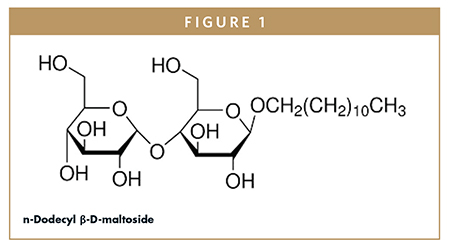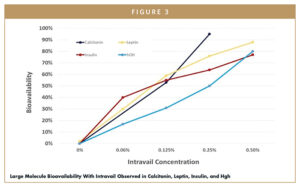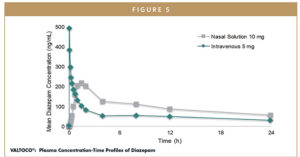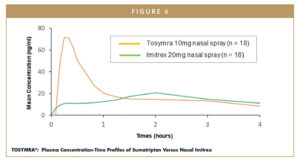Issue:March 2022
NASAL DELIVERY - Improving Nasal Drug Delivery With Permeation Enhancing Technology
BACKGROUND
Nasal sprays have a long history of use in medicine, but historically, this has been predominantly for their local effects on the mucosa. The treatment of nasal rhinitis (eg, sinusitis, nasal congestion, and /or a runny nose) that are brought about by infections, such as colds and flu, or allergens and irritants, that inflame the mucosa are traditionally treated by the application of a locally acting prescription or over-the-counter (OTC) nasal spray, such as a decongestant, saline rinse, or concomitant antihistamine. It is only recently that the nasal route of administration has come to prominence for the systemic delivery of therapeutics. At the end of the past century, there were relatively few approved nasal spray drug products commercially available in the US: nafarelin, nicotine, and sumatriptan are some early examples. Since that time, there has been a growing interest in nasal delivery for several reasons that cover a wide range of factors evidenced by the significant increase in approved nasal spray drug products for a wide range of therapeutic indications.
The nasal route is appealing for the following several reasons:
- Convenient, non-invasive, and easy to use, either by the patient or a caregiver, resulting in high patient compliance.
- Highly vascularized nasal epithelia that helps systemic absorption promoting rapid therapeutic blood levels that is an important aspect in the “rescue” setting, eg, the use of Narcan® (naloxone nasal spray) for drug overdose or Valtoco® (diazepam nasal spray) for acute repetitive seizures.
- The potential for direct nose to brain delivery. One of the limiting factors of drugs to treat neurological conditions is their inability to cross the Blood Brain Barrier (BBB). Nasal delivery provides a direct route to the CNS via the trigeminal nerve and olfactory lobe. This direct route may also contribute to the rapid onset aspect of nasal delivery.
- No first-pass metabolism, making it an attractive alternative to oral dosing where this is an issue.
The delivery of the dose is achieved by a nasal spray pump. This technology is well established, and there are numerous commercial manufacturers supplying nasal sprays in various configurations with respect to single or multi-dose units with an array of delivery volumes, typically in the range 25 μL to 100 μL.
Nasal delivery, however, does have challenges. The delivery volume limitation precludes high drug load products that may be solubility limited. At volumes more than 100 μL, there is the possibility of leakage through dripping back out the nostril or going past the upper reaches of the nasal passage to be swallowed via the esophagus, resulting in a sub-optimal dose. This constraint is compounded to some degree by the limited solvent systems that can be used due to the sensitive nature of the nasal mucosa and the need to limit any nasal irritation that may result from drug administration.
A final challenge is the need for rapid absorption. The nose has a mucocilliary clearance system that effectively replaces the mucosal film approximately every 15 to 20 minutes so rapid absorption is critical for achieving high bioavailability. It is this aspect of nasal delivery that can be significantly improved by the incorporation of a permeation enhancer into the drug product formulation.
PERMEATION ENHANCERS
Although the main respiratory chamber of the nose has a large surface area (approximately 130-160 cm2) and is highly vascular, the concentration of the drug is progressively reduced by the action of dilution from regenerating mucosal coating and by mucocilliary clearance that physically removes the drug. Absorption, therefore, must be rapid, ideally significantly less than 15 minutes. Because of these factors, improving the rate of absorption also increases the extent of absorption as more drug is absorbed before it gets diluted and washed away.
Understanding that there are significant constraints on the formulation itself, the incorporation of a permeation enhancer is an ideal solution to facilitate improved drug uptake into the systemic circulation. Throughout the past several decades, a range of compounds have been investigated as potential permeation enhancers. A comprehensive review of transmucosal absorption enhancers covering various routes has recently been published demonstrating the wide interest in this field.1 This review focuses on the use of alkylsaccharides as absorption enhancers for nasal delivery of a wide range of drug types.
ALKYLSACCHARIDES
The alkylsaccharides are a family of non-ionic compounds consisting of a sugar moiety linked to an aliphatic carbon chain by a glycosidic or ester bond, and certain of these have shown to provide absorption enhancing properties. The sugar can be one of numerous oligosaccharides (typically a disaccharide) and the aliphatic chain is typically 8-18 carbons. An alkylsaccharide approved for use in commercial products in the US (Valtoco® and Tosymra®) is Intravail A3, n-dodecyl β-D-maltoside, shown in Figure 1.

An important physicochemical property of Intravail A3 is its amphiphilicity. The hydrophilic-lipophilic balance (HLB) for Intravail A3 is approximately 14, giving it detergent-like properties. This versatility enables its use with a wide range of drugs across a broad spectrum of log P values in aqueous or non-aqueous solvent systems, enabling the formulator a wide choice of solvent systems.
SAFETY
Alkylsaccahrides are odorless, tasteless, and are essentially non-toxic and non- mutagenic (oral “no observable effect level” is ~20,000-30,000 mg/kg of body weight).2 They are metabolized to their corresponding sugar and fatty acid following absorption.3,4 Alkylsaccharides are used extensively in the food industry and are generally recognized as safe (GRAS) by regulatory authorities for food applications. Intravail A3 has been studied extensively in numerous animal models with a variety of drugs and delivery systems, and no toxicities have been observed. To date, there have been no data that indicate any issues with respect to damage to the epithelial cell membrane, and mechanistically, the permeation enhancement is transient, and once the Intravail has been removed by mucocilliary clearance, the epithelial morphology returns to its native state.
MECHANISM
To achieve systemic absorption, the drug must cross several barriers. First, there is a mucus layer that, as described earlier, is continually regenerating. Then, the drug must cross through the epithelial layer to the basement membrane before finally traversing into the capillary endothelium and thence to the systemic circulation. There are two primary mechanisms for absorption through the epithelial layer:
- Paracellular transport through opening of tight junctions between cells.
- Transcellular transport or transcytosis through cells through vesicle carriers.5,6
Facilitating transport across the epithelial layer is the key to improving drug absorption. The layer consists of columnar cells interconnected via tight junctions. Small hydrophobic drugs can partition transcellularly via a concentration gradient, whilst small hydrophilic drugs benefit from an active transport mechanism (eg, vesicle formation). Larger drugs and hydrophilic drugs may also get absorbed via the paracellular pathway.
The addition of a non-ionic surfactant, such as Intravail A3, is believed to act via both mechanisms, although few definitive studies have been performed. In paracellular transport, it is likely the alkylsaccharide temporarily disrupts the interactions of the membrane proteins that maintain the tight junctions.7 This loosening facilitates drug transport across the epithelia, allowing a drug to pass through more easily and quickly. Similarly, Intravail A3 may have a transient effect on the cell lipid membrane, disrupting it to allow a drug to pass into the cell or by active transport whereby a hydrophilic drug is encapsulated in an alkylsaccharide lipid vesicle and internalized into the epithelial cell.
The opening of tight junctions is particularly important for large molecules (proteins and peptides) that are typically poorly absorbed. Paracellular transport is typically restricted to molecules with radii of less than 1.1 nm.8 The improvement in absorption of peptides and proteins is shown in the Examples section below (Figure 3). These data are taken from several publications using the same preclinical species, rat, and replotted on a single graph for comparative purposes.5 In this instance, the alkylsaccharide is a C14 aliphatic chain maltoside. In each case, the authors are comparing nasal administration to subcutaneous injection at the same concentration except for calcitonin, which was compared to the corresponding intravenously administered dose of calcitonin, thus providing absolute bioavailabilities in this case.
There are two general trends that are observed. First, as the absorption enhancer concentration is increased from 0% to 0.5%, the bioavailability of each peptide or protein increases. Second, as the molecular weight increases from 4 kDa for calcitonin to 30 kDa for erythropoietin, the bioavailability at any given concentration of Intravail decreases. While the general trend of an inverse relationship between molecular weight and bioavailability is observed, there is also an indication of idiosyncratic differences between peptides. Specifically, while leptin is 16 kDa compared to insulin at 6 kDa, leptin has comparable bioavailability despite its higher molecular weight. It is worth noting that while rat data is generally accepted as indicative of general bioavailability trends in nasal delivery (with the reported exception of delivery of powders), inter-species differences in nasal morphology and physiology are known to exist, and the relative benefits and deficiencies of the variously employed animal models, which include rat, guinea pig, rabbit, dog, sheep, and various primates have been reviewed in detail with primates, not unexpectedly, generally considered the best nonhuman model species.9
Studies have been done that look at changes in trans-epithelial electrical resistance (TEER).10 In this type of study, human tracheal and broncoepithelial cells are grown to confluence in a microtiter well in a system that has been used as an in vitro screening model for nasal adsorption enhancement.11,12 Tight junctions prevent ion flow when an electrical potential is applied thus reduction in TEER is a measure of tight junction opening. These experiments demonstrated Intravail A3 provided a significant reduction in TEER, which is indicative of loosening of tight junctions.
The transient effect of Intravail has been demonstrated in a PK study in rats administered calcitonin and somatotropin nasally under three sets of conditions.13,14 Figure 2 summarizes the results. The uppermost curve for both proteins shows the pharmacokinetic profile when Intravail and drug are mixed and presented together (0 minutes). The next line shows the pharmacokinetic profile when Intravail is separately administered intranasally, followed 60 minutes later by a drug. Similarly, the lower line shows the pharmacokinetic profile when Intravail precedes drug administration by 120 minutes.

For the smaller molecule, calcitonin at 4 kDa, shown in the left panel, substantial absorption still takes place when the drug is administered 60 minutes after exposure to Intravail although the mucocilliary clearance half-time is approximately 15 minutes. Even 2 hours after Intravail administration, a small but significant amount of calcitonin is still able to enter systemic circulation, indicating the tight junctions are still partially open.
For the larger protein, somatotropin at 22 kDa, shown in the right panel, absorption takes place when the drug is administered in the presence of Intravail (0 minutes), but the tight junctions are already sufficiently closed at 60 minutes and 120 minutes to prevent essentially all passage of the protein. These results illustrate two important features of Intravail. First, the opening of tight junctions is a transient reversible phenomenon. Second, the excipient functions by acting on the mucosal membrane, not through direct interaction with these drugs, for example, by forming by drug-containing micellar inclusions, because the Intravail and drug can be administered separately physically and temporally.
Examples
Figure 3 shows the relationship between Intravail concentration and bioavailability for a range of compounds of varying molecular weights: calcitonin (~3.4kDa), Insulin (~5.8kDa), Leptin (~16kDa), and human growth hormone, hGH (~22kDa) have been shown to increase bioavailability compared to intramuscular and subcutaneous injections. There is a significant improvement in bioavailability over the Intravail concentration range studied.
Figure 4 shows the plasma concentration-time profiles of a 1-mg intranasal dose of NeffyTM (an investigational formulation of epinephrine with Intravail) and 0.3-mg intramuscular (EpiPen®) and subcutaneous (Auvi-Q) injections of epinephrine. The data showed the intranasal spray absorption reaching 100 pg/mL within 9 minutes compared to 20 minutes for intramuscular and subcutaneous injections. Similarly, the maximum concentration (Cmax), was achieved in 20 minutes with the intranasal dose compared to 45 minutes for intramuscular and subcutaneous injections.
Figure 5 shows the plasma concentration-time profiles of a 10-mg intranasal dose Valtoco® (diazepam formulated with Intravail) and 5-mg intravenous injection of diazepam. The data showed the intranasal spray absorption, determined by the area under the curve (AUC), is comparable to the AUC for the injection and the absolute bioavailability of the intranasal spray is 97%.
Figure 6 shows the plasma concentration-time profiles of a 10-mg intranasal dose of Tosymra® (sumatriptan formulated with Intravail) and 20-mg intranasal dose of Imitrex (sumatriptan without Intravail). The data showed that Tosymra has a relative bioavailability of 200%, determined by the area under the curve (AUC), and Tmax is reduced from 120 minutes to 15 minutes. In addition, in a clinical study, Tosymra demonstrated 87% bioavailability to 4-mg subcutaneous injection of sumatriptan (data not shown).
As a further illustration of the broad applications of the Intravail technology, Neurelis has granted a license to DIODEM Therapeutics, a recently formed start-up company, for oral and nasal administration of a novel small peptide drug candidate developed at Albany Medical College in Albany, NY. This peptide addresses the major metabolic and neurologic dysfunctions associated with Down syndrome: weight gain, diabetes, peripheral and central insulin resistance, and Alzheimer’s Disease-like disruption of cognitive function.
SUMMARY
The formulation of drugs to improve suboptimal pharmacokinetics or pharmacodynamics has been an ongoing challenge in pharmaceutical development. With the growing interest in nasal delivery for its inherent advantages over other routes of administration, improvements in rate and extent of absorption are critical components for this route of delivery. Equally fruitful and more challenging reformulation opportunities exist in the case of certain peptide and protein drugs. Intravail can be used to meet these challenges across a broad range of molecules in terms of molecular weight and lipophilicity.
The nasal route is an effective administration option for both local and systemic drugs, and significant advantages can come from delivering drugs through the nose. It is a relatively noninvasive approach with simple administration that offers the potential for patient self-medication. In addition to systemic and local access to the nose and sinuses, this can be a route of delivery for multiple target sites, including direct delivery of therapeutics to the brain bypassing the BBB. The anatomy of the nose presents unique challenges for drug delivery however, including dose-volume constraints, drug delivery and potential irritation concerns, and limited residence time requiring rapid and efficient absorption. The use of permeation enhancers offers an attractive option for improving absorption.
REFERENCES
- Transdermal Absorption Enhancers in the Drug Delivery Field. Edited by Casettari, Maher and Illum. MDPI Books, ISBN 978-3-03921-849-3, Jan 2020.
- Maggio ET. Expert Opin Drug Discov. 2006; 3(4):529-539.
- Food Additives Series 40: Sucrose Esters of Fatty Acids and Sucroglycerides. 49th Meeting of the Joint FAO/ WHO Expert Committee on Food Additives (JECFA): Geneva, Switzerland, 1998; http://www.inchem.org/documents/jecfa/ jecmono/v040je04.htm.
- Weber N, Benning H. Metabolism of Orally Administered Alkyl Beta-Glycosides in the Mouse. J. Nutr. 114(2) 1984: 247-254.
- Arnold JJ, et al. Correlation of Tetradecylmaltoside Induced Increases in Nasal Peptide Drug Delivery with Morphological Changes in Nasal Epithelial Cells. J. Pharm. Sci. 93(9) 2004: 2205-2213.
- Marttin E, et al. Confocal Laser Scanning Microscopic Visualization of the Transport of Dextrans After Nasal Administration to Rats: Effects of Absorption Enhancers. Pharm Res. 14(5) 1997: 631-637.
- Ahsan, F.; Arnold, J.; Meezan, E.; Pillion, D.J. Enhanced bioavailability of calcitonin formulated with alkylglycosides following nasal and ocular administration in rats. Pharm. Res.-Dordr. 2001, 18, 1742-1746.
- Ghadiri, M et al. Strategies to Enhance Drug Absorption via Nasal and Pulmonary Routes. Pharmaceutics 2019, 11, 113.
- Illum L. Nasal delivery. The use of animal models to predict performance in man. J Drug Target. 1996;3(6):427-42.
- Chen S-C, Eiting KT, Li AAW, Lamharz N. and Quay SC. Peptide drug permeation enhancement by select classes of lipids. 45th American Society for Cell Biology Meeting, December 10-14, 2005, San Francisco (late abstract).
- Scotto-Lavino E, Easow J, Simon S, Roemer E. An in vitro model for the rapid screening of potential components and formulations for nasal drug delivery. In Vitro Cell Dev Biol. 2002;38:12A.
- El-Shafy MA, Roemer E, de Meireles J, Biswas M, Quay SC. Permeability and cytotoxicity of macromolecules from nasal formulations using EpiAirway™ tissue model. AAPS Pharm Sci. 2001;3(3):S-58.
- Arnold JJ, Fyrberg MD, Meezan E, Pillion DJ. Reestablishment of the nasal permeability barrier to several peptides following exposure to the absorption enhancer tetradecyl-b-D-maltoside. J Pharm Sci. 2010;99(4):1912-20.
- Ahsan F, Arnold J, Meezan E, Pillion DJ. Enhanced bioavailability of calcitonin formulated with alkylglycosides following nasal and ocular administration in rats. Pharm Res. 2001;18(12):1742-29.
To view this issue and all back issues online, please visit www.drug-dev.com.

Dr. Stuart Madden is Chief Scientific Officer at Neurelis and has more than 30 years of experience in the pharmaceutical industry working on drug development programs, from proof of concept through to commercialization for New Chemical Entity (NCE) and 505(b)(2) products that have encompassed small molecules, biologics, and combination products. He has worked with Neurelis since 2008, supporting the development of VALTOCO®. Dr. Madden has previous experience in roles providing strategic consulting expertise to biotech and pharmaceutical clients, and in the development and commercialization of controlled-release oral dosage forms. He earned his BS in Chemistry and his PhD in Physical Chemistry from the University of Wales, Swansea, UK, and spent 2 years as a post-doctoral fellow at San Diego State University, CA. He is a Chartered Chemist and Fellow of the Royal Society of Chemistry and a past special government employee for the FDA’s Advisory Committee for Pharmaceutical Science and Clinical Pharmacology.
Total Page Views: 8467














